July 26, 2022 – Volume 24, Issue 7
In This Issue
- Flanigan’s Eco-Logic: The Elevator Update
- The U.K.’s Low-Cost Renewable Tender
- Agrihoods: Urban Planned Communities
- Batteries Addressing California’s Heat Waves
- Swiss Pumped-Hydro Storage
- Sand and High-Rise Battery Innovations
- Shared Mobility and Active Transportation
- Flanigan’s Eco-Logic Podcast Updates
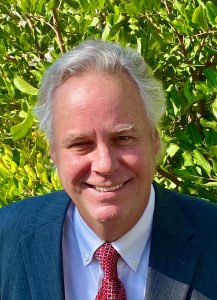
Flanigan’s Eco-Logic: The Elevator Update
Elevators are now being deployed that have no cables. Instead they are lifted with magnets. They’re like mag-lev trains, guided by rails, advanced and controlled with magnetism. For some of us, that’s a scary thought. What if the power goes out? Of course they have that figured out. But when the first mag-lev elevators were introduced, shock waves apparently reverberated through the vertical transportation industry.
Thyssenkrupp is a German elevator maker. It’s clearly an innovator, pioneer of the world’s first non-cabled elevator system, what it calls its “Multi” system. In addition to a novel form of propulsion, it presents a revolutionary design. When a cabin reaches the top of its channel, it can shift horizontally to then come down a parallel shaft. Thus each shaft can have multiple cabins operating at the same. This allows for greatly increased capacity, with elevators configured more like a circuit or metro system.
Let’s back up: The first “fall safe” passenger elevator was built in 1852 by Elisha Graves Otis and installed and exhibited in 1854 at the Crystal Palace Convention at New York’s World Fair. His braking system worked and ushered in a movement of elevators. The first high-rises were built in the United States in the 1880’s. Land was at a premium and urban populations were growing. Building up was the only option, as long as you had one of Otis’s lifts. The first electric elevator was built by Werner von Siemens in Germany.
The mag-lev elevator was introduced in 2007. These elevators use a mag-lev track in the building which is embedded with coils to guide the cabins through a moving magnetic field… this is known as a linear drive. A magnetized coil running along these shafts repels magnets located in the elevator cabin, causing it to levitate. The elevators have electromagnetic brakes that engage when the car comes to a stop. The brakes will automatically clamp shut if the elevator loses power.
For the past several years, the mag-lev elevator system has been tested in a test tower in Rottweil, Germany. The facility, called the Thyssenkrupp Testturn, opened in 2017 and is 807 feet tall. Its public visitor platform at 761 feet is the highest visitor platform in Germany. The first building using this Multi technology is the East Side Tower in Berlin which is due to open in 2023. The premium elevator system costs five times standard elevator equipment prices.
One of the great features of the mag-lev elevators and the Multi system is that they address urbanization: Globally, urbanization is on the rise, with ever-taller apartment towers. Traditional elevator cable systems can only lift cabins ~1,600 feet. Thus taller buildings require multiple banks of elevators. With magnetic elevators, there is no height limit, a big plus as more and more people live in high rises and demand timely elevator service. And computer-controlled and synchronized horizontal service may revolutionize the singular and siloed notion of an elevator shaft.
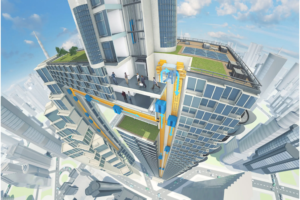
Image Courtesy of Thyssenkrupp
Globally, 55% of people live in cities today. This is expected to rise to 68% by 2050; there’s a projection of about 6 billion urbanites then. Efficient elevators are needed to provide for vertical habitation of super-tall (>984 feet) and mega-tall buildings (>1,969 feet). Mag-lev elevators, with the horizontal shift feature, may play an important role in our efficient ingress and egress of our elevated homes. Think Chutes and Ladders!
Fact of the Week
“Eye-watering gas prices are hitting consumers across Europe. The more cheap, clean power we generate within our own borders, the better protected we will be…”
Discussing the U.K.’s record-setting wind auction
The U.K.’s Low-Cost Renewable Tender

The United Kingdom’s latest tender for 7,000 MW of offshore wind has resulted in record-low prices, 5.8% cheaper than the last auction in 2019. Tenders are similar to auctions but use sealed bids. The biggest tender ever, it brings the U.K. closer to its goal of installing 50,000 MW of offshore wind by the end of the decade to achieve its target climate protection goals.
The price of offshore wind has fallen 67% in less than a decade according to Bloomberg. The tender resulted in a price of $44 per MWh, about a quarter of the U.K. day-ahead power price. The prices were down despite increased costs for steel and supply-chain disruptions. Winning bidders included Orsted A/s, Iberdrola SA’s Scottish Power unit, Vattenfall AB, and a project including AB Ignitis Grupe, EDP Renovaveis SA and Engie SA.
Part of the tender, Danish company Orsted was awarded a contract for the world’s biggest offshore wind project at Hornsea Three. It is 100 miles off the East Yorkshire coast. The tender offered a “contracts for difference” arrangement. If the market price falls below this tender’s contract price of $45/MWh, the government will subsidize and pay the difference.
Given war in the Ukraine, the U.K. and the entire European Union are stepping up their renewables resolve. Russia’s invasion of Ukraine has exacerbated an already volatile oil and gas market in Europe. In this instance, the United Kingdom has eased its moratorium on onshore wind farms that has been in place since 2015. Onshore wind and solar were included in this tender, with the cost of onshore wind now about 45% of the price it secured in 2015.
To bring all this power to land and homes and businesses, National Grid laid out a plan this past month for a ~$64 billion infrastructure upgrade. Much of this involves connections to offshore wind farms. National Grid has proposed 15 connection points to bring 18 offshore wind farms to land. By coordinating the distribution of offshore farms, National Grid intends to drive down the consumer cost by alleviating redundancy and inefficiencies, notably reducing the number of pylons and cables needed to bring power ashore.
Meanwhile, a Turkish tender for 1,000 MW of solar PV has resulted in low prices… $0.031 cents per kWh, or $33/MWh. The deal is based on 15-year power purchase agreements (PPA). Turkey’s Ministry of Energy has allocated 700 MW of the 1 GW tranche – known as the YEKA 4 PV Tender. The Ministry selected two 200 MW projects and ten 50 MW projects. For the first time, Turkey specified domestic content requirements for the equipment.
Agrihoods: Urban Planned Communities

In the United States, food travels 25% further than it did 20 years ago. Freshness suffers and so does the environment. Agrihoods address this in part. They are neighborhoods that combine food and real estate, farm-centered communities. They embody a healthy, sustainable farm-to-table focus.
Agrihoods are alternatives to regular neighborhoods. Instead of clubhouses, pools and tennis courts, these neighborhoods prioritize sustainable agriculture. They are generally managed, working farms. Barns double as event spaces. Outdoor kitchens feed families. Sometimes there are farm-to-fork cafes and restaurants on site.
The Cannery in Davis, California is a noted, new agrihood. The site was a Hunt-Wesson tomato canning facility. Now its residents are taking pride in how hyper-local agriculture is building a sense of community. The 7.4 acre farm is managed by the Center for Land-Based Learning, a non- profit supporting agricultural programs for students and aspiring farmers. All 547 homes are solar ready, providing prospective buyers a pathway to net zero.
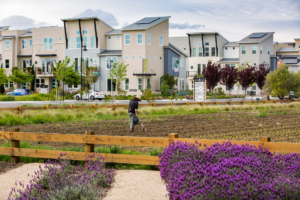
Agrihoods are also called “agritopias” and “agriburbia.” Agrihood Living is a website platform with an agrihood locator, information on featured communities, videos, a podcast, FAQ… all means to plug in. Housing sales in agrihoods are reportedly brisk. The Urban Land Institute estimates that there are now 200 agrihoods across the United States. Beyond a place to live, they are the basis for an improvement to the dominant food system. They tackle food insecurity and help low-income communities get fresh, healthy food.
Detroit’s agrihood is a project of the Michigan Urban Farming Initiative (MUFI), an all-volunteer nonprofit. What a ray of light; Detroit is known as one of the nation’s most dangerous and violent cities. The MUFI agrihood project is made up of three acres of vacant land where 300 organic vegetable varieties are now grown… vegetables like lettuce, kale, and carrots. There’s a 200-fruit tree orchard of apples, pears, plums, and cherries. There’s a children’s sensory garden, an edible garden. The 50,000 pounds of food grown annually is available for free to about 2,000 households. The farm is open for harvesting on Saturday mornings.
Detroit’s MUFI agrihood has a broad vision. Its next step will be to build a community resource center with educational programs and meeting space, a cafe, and two commercial kitchens aimed at creating an economic opportunity for residents to be able to sell hot sauces made from fresh peppers and tomatoes and herbs grown onsite.
Batteries Addressing California’s Heat Waves

Image Courtey of Vistra Energy
BloombergGreen reports that batteries are now substantially shoring up power grids during heat waves and to meet peak demand. The California Independent System Operator (CAISO) Annual Report presents a table of 2022 Summer Maximum On-Peak Available Capacity. Batteries now make up 6% of the anticipated Summer Maximum On-Peak Capacity. Last year the same value was 2.8%; the year before it was 0.7%. It was 0.1% in 2017, just five years ago.
Last summer, the CAISO reported 1.5 GW of utility-scale storage capacity under its control. By April 2022, there was 2.7 GW of connected storage, anticipated to grow to 4.0 GW this summer. The ISO is routinely shifting 6 GWh, or 6,000 MWh of electricity… and regularly sees five-minute intervals where all the stored energy is dispatched to the grid. In March, the CAISO system peaked at 28,971 MW and storage was able to provide for 10% of the peak.
The six percent contribution compares with 2.2% available from demand response. Batteries also provided more summer on-peak available capacity than wind and geothermal combined. And on July 15th, and for about half hour in the early evening, batteries provided more power to the California grid than nuclear. Batteries are coming of age. In addition to the utility-scale storage, by the end of 2021, there were > 62,000 behind the meter battery installations in California providing 740 MW of capacity, mostly controlling site loads but also contributing to the resilience of the grid.
Texas has 2,300 MW of batteries currently installed with more than 7,000 MW planned to come online by the end of 2023. There, conservation is also making a substantial contribution to cutting peak demand. ERCOT, the Electricity Reliability Council of Texas, reports that Texans conserved 500 MW of demand last week in response to a second plea for conservation. On Wednesday, July 13, demand was forecasted to reach 79,671 MW. By 5 PM the number had topped 78,370 MW and with summer heat depressing wind capacity, and reserves dropped to below 2,300 MW for over 30 minutes. That triggered another call for consumer conservation with the dire warning of rolling black-outs. The result: 500 MW in four minutes. ERCOT notes that calls for conservation have been used more than four dozen times since 2008 to maintain grid reliability.
Swiss Pumped-Hydro Storage

It took 14 years to complete. It’s being described as an “underground water battery.” What is it? It’s a pumped-hydro storage plant in the Swiss Alps made up of two 11-mile long tunnels connecting two reservoirs at different elevations. The system provides a whopping 20 GWh of storage. It began operations on July 1st.
The system was constructed by Nant de Drance. It’s located in Finhaut in the canton of Valais, Switzerland. It cost $2.1 billion. It is one of Europe’s largest pumped-hydro storage facilities. It is jointly owned by Swiss renewable energy producer Alpiq (39%), the Swiss Federal Railways (36%) Industrielle Werke Basel (15%), and Forces Motrices Valaisannes (10%). Construction began in 2008 using two different water reservoirs at the Emossum Dam which was completed in 1974.
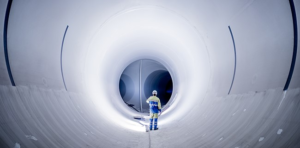
The power generator is made up of six reversible pump-generators with a combined 900 MW capacity. The power plant is located in a cave 1,969 feet underground between the Emossum and the Vieux Emossum reservoirs. The system’s water storage capacity is 184,000 acre feet. The project required the excavation of 141 million cubic feet of rock and drilling of 11 miles of galleries.
Sand and High-Rise Battery Innovations

Image Courtesy of Polar Night Energy
Sand Batteries: There are so many forms that batteries may take… from “conventional” lithium-ion, to “flow batteries,” to silicon phase-change batteries, molten salt batteries, iron-air batteries, gravity batteries, carbon dioxide expansion batteries… even buoyancy batteries.. So many forms of battery energy storage, and now another: sand batteries from Finland.
As vanadium flow battery expert Matt Harper explained in a recent Flanigan’s Eco-Logic Podcast, differences in size, longevity, installation and operating costs, duration… all will define applications. Different chemistries each will fulfill useful roles. Some will be targeting spikes in demand and smoothing out daily load profiles, others working away at base demand during peak periods., while others will offer grid ancillary services and end-user resiliency.
The Finnish company, Polar Night Energy, recently built and began to operate the first commercial sand battery at the premises of new energy company Vatanjankoski, located a few hours from Helsinki in Western Finland. The system takes excess electricity and turns it into thermal energy which is stored and then later used in a district heating loop. Its developers say it’s easy to take electricity and store it as heat. Turning it back to electricity is a greater challenge.
The thermal energy storage system is made up of a big insulated tank, 13 feet in diameter and 23 feet high. It’s full of “plain old sand.” When heated up, using a heat exchanger buried in the middle, it is capable of storing 8 MWh of energy and releasing it at a rate of 100 kW. The sand is heated to ~1,000 degrees F. Polar Night Energy claims tremendous storage efficiencies, that its systems can store heat for months if need be.
Sand batteries may constitute very low-cost systems thanks to their super low to zero-cost storage medium. A cost of less about $10 per kWh is cited. Sand batteries may be great for countries like Finland where there may be no direct sun for weeks in winter. Sand batteries’ long duration storage may well keep buildings heated cheaply and cleanly through freezing Finnish winters.
Two future looks: Polar Night notes that there is the potential to create bulk underground sand storage facilities out of disused mine shafts. And, sand batteries in the future may be designed with multiple zones, longer-term heat stored toward the center of the cylinder, shorter-term repeated use cycles closer to the top surface.
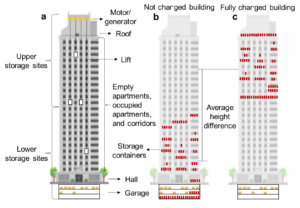
Image Courtesy of IIASA
High-Rise Gravity Storage: More on elevators. Here’s an idea from Vienna, Austria and the International Institute for Applied Systems Analysis (IIASA). Its analysts believe that gravity energy storage systems using high-rise buildings may be an inexpensive and easy-to-implement form of storage. Imagine using high-rises and their existing elevator systems. By lifting weight up high during off-peak periods, it can be released through regenerative braking during peak periods. Introducing LEST, Lift Energy Storage Technology.
According to New Atlas, IIASA researchers have evaluated buildings and found, “a huge amount of pre-built energy storage waiting to be unlocked.” They claim that all you need is storage space at the top and bottom of a high rise building to store heavy, wet sand containers or other high-density materials. Autonomous carts can shift the loads out of storage and into elevators. Most elevators are already equipped with regenerative braking on descent. In this way, elevated heavy weights can “charge” a building… readying it for costly peak periods. Naturally weight may be a structural issue, especially on upper floors.
Shared Mobility and Active Transportation

Shared mobility, some say, is the mobility of tomorrow. It includes public transportation – buses, trains, light rail, and ferries – car sharing, bike and scooter sharing, and carpooling. The average public transit user saves around $10,000 per year compared to owning a car, while improving local air quality, easing traffic congestion, creating less need for parking, and using less petroleum and lithium.
Fully 24% of U.S. CO2 comes from transportation emissions. And within that slice of the pie, over 50% comes from passenger vehicles. Globally, CO2 emissions from transport are 45.1% from passenger vehicles, 29.4% from road freight, 11.6% from aviation, 10.6% from shipping, 1% from rail, and 2.2% “other,” mostly pipeline energy. So passenger vehicles, especially when there are no passengers, are in focus for reform. Policies to support shared mobility and active transportation – biking and walking – are climate effective.
Los Angeles Metro operates the nation’s largest clean air bus fleet, plus a growing light rail line network throughout Los Angeles. We’re pleased to report that it has announced a new “active transportation” corridor, 5.5 miles of bike and pedestrian paths along Slauson in South Los Angeles. It is a former freight line that cuts an east-west swath through Inglewood, South LA, and the unincorporated community of Florence-Firestone. The corridor will serve a portion of LA County which has among the highest percentage of residents who commute via transit, cycling, or walking. Fully, 19% of households there lack access to a car.
The project is a strategic link for mobility and access. The corridor links users to the Crenshaw LAX light rail line, the Silver Line busway, and the Blue Line. It refreshes an abandoned and blighted railway, turning it into a world-class bike and pedestrian path that supports active transportation.
The project’s estimated cost of $143 million includes new landscaping, hundreds of shade trees, security cameras, street furniture, signage, and improvement to 22 intersections. The City of Los Angeles is partnering and working on zoning changes to orient future development on the trail. It is also planning new parks along Slauson at Normandie Avenue and Figueroa Street.
Flanigan’s Eco-Logic Podcast Updates
Recently Released:
This issue features stories on mag-lev elevators, the U.K.’s largest and most cost effective offshore wind tender, agrihoods taking root, sand and high-rise battery energy storage innovations, batteries substantively addressing California’s summer heat waves, as well as a brief and highlight on shared mobility and active transportation.
In this episode of Flanigan’s NetPositive Podcast, we listen and learn from Susan Eirich, Executive Director of the Earthfire Institute, a wildlife sanctuary, rehabilitation center, and retreat destination in Driggs, Idaho. She’s a profound thinker, a marvelous communicator, and a passionate do-er. She discusses the value of “reconnection ecology” to reawaken our relationship with wildlife and nature, expanding our sense of community to include all living beings and moving us to protect thriving habitats for all life.
Susan talks about her past and the route that brought her to Earthfire via the Amazon, Tibet, and working as a prison psychologist. She speaks of her love for the West and her deep connection and instinctive understanding of wolves. Today, Earthfire Institute houses bears, wolves, and a menagerie of mammals native to the Yellowstone to Yukon wildlife corridor. Visitors, by appointment only, are welcome to observe and connect for a few hours, or even a few days!
Great discussion with Chris Klinga, founder and CEO of Solmotiv, a Boulder, Colorado-based firm focused on applications of architectural glass. Solmotiv serves building owners and technology providers with its expertise in combined structural, mechanical, and electrical engineering for architectural glass applications.
Chris clarifies the definitions of building integrated photovoltaics and architectural solar, the latter being fully baked into a building’s design process. In many cases, architectural solar can replace building construction components, like window walls of PV IGU — the insulated glass units common in commercial buildings, and skylights.
The conversation gets deep when new photovoltaic Rapid Shutdown requirements for architectural glass came up … and lightens up with a brief discussion of the magnet that drew Chris to Colorado and the skiing and climbing that he loves there to this day.
Check out and subscribe to Flanigan’s Eco-Logic Podcast on Spotify, Apple, and Google. Episodes include Convos, Crash Courses, and EcoNet News.
